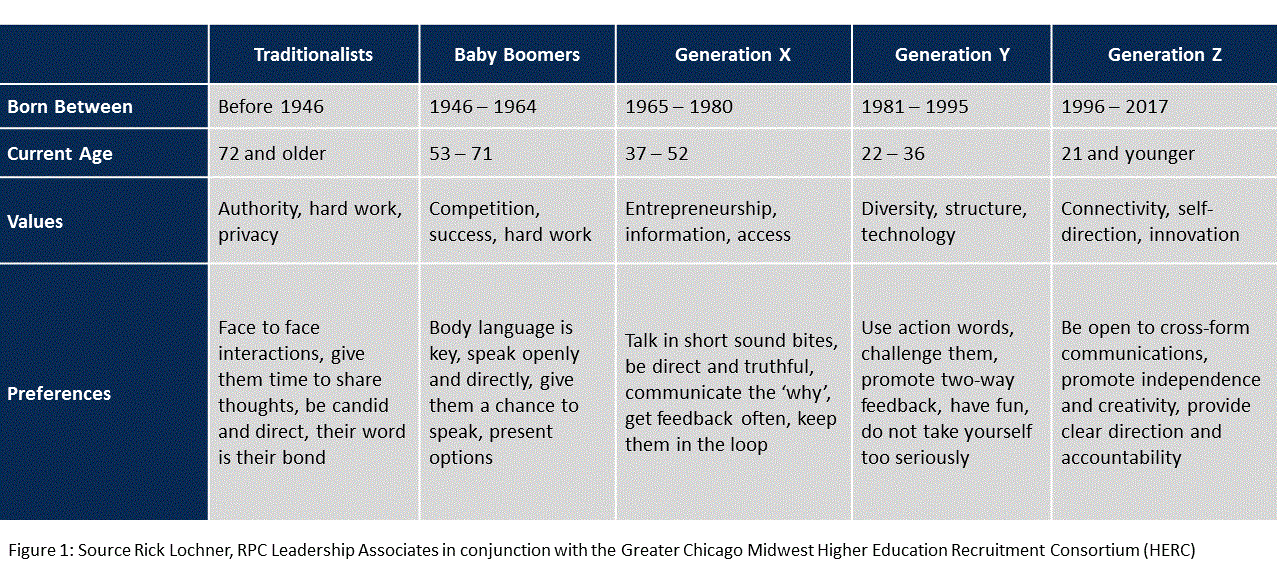
Nov. 13, 2017 | InBrief
The ABCs of working with generation X, Y and Z
The ABCs of working with generation X, Y and Z
By 2020, Millennials (also known as Generation Y) will represent half of the global population. Furthermore, Baby Boomers (those born between 1946-1964), will be retiring at a faster pace than ever. Generation X will not be able to fill all of the open positions, pushing Generation Y into leadership roles much sooner than previous generations. Simultaneously, the rise of Generation Z and future generations will make it imperative for companies, institutions, and employees alike to invest time and effort into building strategies and skills tailored to meet this ongoing and significant shift in the workforce. Putting a focus on improving communications, effective listening, and reframed attitudes, the boundaries between generations will begin to fade, and result in a community that is more efficient, engaged, and happy at work.
A closer look at the existing values and preferences of the different Generations is shown in Figure 1. Based on the current ages shown, you will see that a majority of the five existing generations are still active in the workplace. Even some within the Traditionalist generation are still working due to healthcare advancements and new financial constraints, making retirement before age 65 a challenge. Yet, each generation is strikingly different in their preferences for interaction, engagement, and communication. When comparing generations, it is important to realize that boundaries can sometimes be a matter of perception instead of fact. Not all people align directly with the values and preferences within the generation they fall, however these are the over-arching themes.
According to Rick Lochner, of RPC Leadership Associates, it is important to focus on the psychographics, not just the strict demographics of each generation. Psychographics are the critical piece to understanding people’s true motivations and values that direct their day-to-day activity and connections. Most importantly, they can guide the strategies for how companies and employees effectively engage one another to bridge the gap between generations and be more successful as a whole.
Here are a few rules that should be considered when working across generations:
Improve Communications by Knowing Your Audience
A refocused effort on teaching and building the skills necessary to understand your audience and effectively transfer meaning through engaging is imperative to succeeding in cross-generational communications. Specifically, this requires a better understanding of how each generation prefers to be communicated with and how they best comprehend information. For example, Baby Boomers traditionally prefer face-to-face interactions, while Gen Y and Gen X prefer texting, video, and social media. Gen X wants to consistently understand the ”why” of a recommended solution, action, or idea to help them best frame up the purpose and plan. Gen Y prefers to hear action words in their dialogue with managers ̶ ones that clearly articulate the actions being requested of them ̶ in addition to effectively challenging them to think outside the box. There is not a "one size fits all" model, so the focus should be on learning the preferences of all generations and improving the approach to communication. Understanding an audience and effectively tailoring interaction styles will inevitably drive better engagement across generations and result in a more engaged workforce.
Focus On Listening to Understand
The one commonality across all generations is that everyone wants to be heard and understood. In our fast-paced and competitive working environment, employees need to spend more time focused on listening to understand instead of to listening to respond. It sounds simple, but both organizations and employees often do not spend enough time practicing the skill of listening, with a very limited number of training courses focused on this subject. For example, Baby Boomers value the opportunity to speak their thoughts, even if the solution to a problem may already be derived. Not all Gen Y’ers have the patience to listen, but it behooves them to do so to make the Baby Boomers feel heard, valued, and more open to driving alignment / agreement. Listening is a soft skill that requires consistent practice, and becomes even more paramount when engaging with employees from other generations. Active listening and meaningful dialogue make people feel truly understood while giving the listener a deeper understanding of who the speaker is and what makes them tick. This helps create a more comfortable environment for everyone to show up, engage with others, and deliver high-quality work.
Reframe Attitude and Perceptions on Generations
One of the major challenges within the multi-generational workforce is the preconceived notions and attitudes that people bring to the table regarding other generations. Gen Y’s (Millennials) are often considered lazy and not as engaged in their work as previous generations due their desire for job flexibility (i.e., work from home, flexible work hours), while the desire for this really stems from the opportunity to be more efficient without office distraction and save commute time. Baby Boomers are consistently portrayed as “resistant to change,” while often they are open to change but need the support, encouragement, and patience to work through it. Additionally, Baby Boomers fear that their resident knowledge based on years of experience will get lost in the shuffle of change. Change is inevitable, but if organizations can promote active dialogue, encourage cross-generational teams, and drive accountability for knowledge sharing, the boundary lines will fade. Each generation needs space to share their experience, insight, and ideas without being held back or downplayed based on preconceived notions or attitudes.
The cross-generational workforce will continue to exist, evolve, and challenge the workforce. No company or industry is immune to this topic. Each party needs to be adaptable, flexible, and open to change. Promoting a company culture that focuses on collaboration, communication, innovation, and openness to new ways of working will drive engagement and happiness for employees. At some level, all organizations are in the “people business,” therefore, this is a call to action to break down age barriers, support a cross-generational workforce, and build a blended communication strategy that brings out the best qualities that each group can offer.

